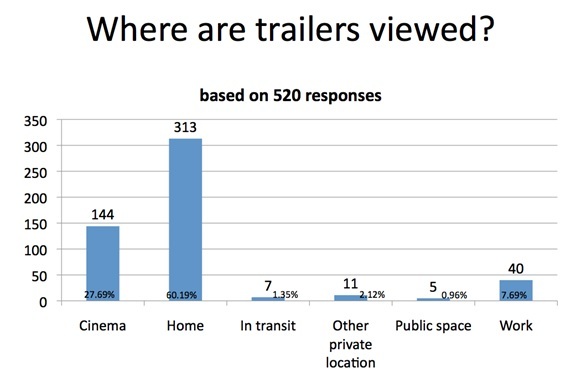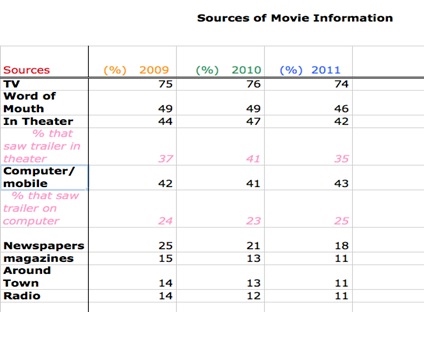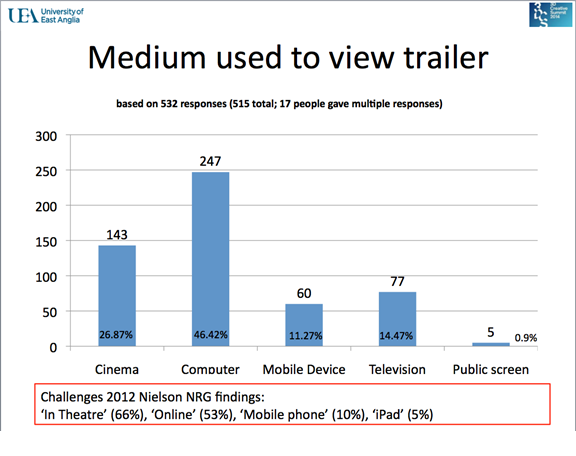We circulated this survey in order to better understand why audiences view trailers. Unlike other commercials, the trailer is one that audiences regularly and repeatedly seek out, engage with and claim to “love.” Given our assumptions about where and through what media trailers are commonly viewed, we anticipated that results would confirm simple and familiar motivations while revealing other complex and eccentric ones.
We knew, or rather believed, that a great deal of trailer viewing occurs in an unmotivated and unfocused fashion—the audience is accidental, the screening is random. While the data broadly affirmed our suppositions, it also underscores the importance--for trailer makers and distributors—of designing trailers for the range of viewing situations, attitudes and demands. The diversity of motivation and the breadth of investment, the variety of contextual and subjective positions inscribed in the responses, deserves to be addressed within these critical and expensive marketing tools.
After asking the name of the last trailer viewed in Question 3, Q4 of our survey asked “Did you seek out this trailer?”
On a purely quantitative basis, more people chose to view the specific trailer mentioned (53%) than did not (47%). Yet that number must be considered alongside a later question (Q10) which asked whether respondents had EVER sought out / searched for any trailer. 81% said yes; only 12% said no. In this post, we combine the findings from Questions 4 & 10 to itemize and describe the reasons given for choosing to view a trailer.
As is well understood within the industry, an effective trailer should keep the wrong audience out while drawing the right one in. This is not done cynically, but in a sincere attempt to minimize negative reactions from an identifiable demographic or group who might otherwise return to the cinema to view a film which they are unable to appreciate. In practice, however, most trailer makers edit for an audience imagined as eager, engaged and able to enjoy the proposed entertainment. For the purpose of this post, we will focus on the 53% and the 81% who actively seek out trailers and examine the reasons they give for why they do so.
(Negative responses, and the views of what we colloquially call “trailer haters,” will be covered in later post.)
Within the group responding positively to Q4 and Q10, a range of locations and media platforms was described. Here, the category of “specific search” includes everything from entering the title into a search engine and deliberately being in the theatre to view the trailers, through clicking on a link in a news article, choosing to watch some (if not all) trailers on a site or DVD, to the minimal and liminal position of deciding “not to skip” the previews at the cinema, on a website or on a DVD. For our respondents (some more discriminating than others), all these activities were considered as demonstrations of positive decision making.
Q4 also invited ‘Yes’ respondents to explain (in 140 characters) why they sought a particular trailer, an option that drew an array of comments about what trailer audiences find most appealing. Information (“learning”) about a film was among the most common reasons adduced, although many other needs, wants and desires characterize the knowledge sought. Q10 followed up this subject of audience demand or expectation, seeking to tease out particulars. The answers provide a more granular account of how audiences use trailers to ‘know more’.
Together, answers to Q4 and Q10 disclose the following, commonly expressed demands, uses and expectations:
1. Responses that play variations on the phrase “so I know what to see,” position trailer viewing as entertainment curiosity and research; knowing more was also valued in order to “confirm” a viewing choice already proposed, whether by the respondent or her viewing partners. Although the demand for reliable evidence is often disappointed (as a result of watching the feature, for example), that possibility appears to be more irritating than surprising to audiences. (We explore this fascinating topic in other posts and research).
2. Audiences want basic factual information, including the nature and sophistication of the content, release date, cast, rating, genre and production information. Often this demand relates to entertainment research pertaining to quality (production value), suitability (whether for a child, a friend, a parent or a date) and fandom.
3. Audiences are motivated by pre-existing interests: a star, a favorite actor, a director, a book that’s been adapted, a genre, sequel or franchise. Here, the trailers are expected to deliver a pleasurable reminder and/or savory taste of a “known” pleasure.
4. Audiences want the trailer to prepare them for the emotional and intellectual experience of the film, imagining and anticipating the film through the surrogacy of the trailer footage. The intensity of the psychological investment in the phenomenology of reception makes it one of the more volatile, not to mention powerful, appeals.
5. Audiences look forward to and anticipate the art and craft of a good trailer. For the high percentage of respondents who self-identified as fans and a significant number who indicated a vocational/educational interest (media-related students and professionals), trailers are conceived as independent film experiences, offering aesthetic pleasures and entertainment rewards distinct from their commercial obligations and derivation.
6. Viewers watch/listen for the sounds and star-power of the cues and the feature soundtrack.
7. Many respondents describe exploring recommendations from peers and the media. Familiarity with the latest trailers is the dues of membership within a social media community or milieu. The film industry has long known the power of “word of mouth. ” Social media has developed and exacerbated the effect. Whatever the “reality” of this communal experience, it points to the trailer’s social exchange value as cultural capital. (The explanation: “I’m a geek” was one clear expression of this tendency, suggesting that trailer viewing may be mandatory within certain subcultures).
8. An interest in independent / foreign film trailers was notable, indicating a persistent curiosity for features that aren’t likely to have “in-theatre” trailers. An urge to support smaller films (by consuming, at least, their marketing) was commonly overdetermined by the emotional / intellectual demands of trailer viewers, described in #4 above.
Information, curiosity, cultural knowledge, a range of pleasures and social pressures: these, then, are the recurring answers to why audiences choose to watch specific trailers. While trailer makers and researchers know these expectations and demands exists, certain of them (aesthetic and cultural ones, for example) are harder to fulfill, perhaps, than evidentiary and informational ones.
Coming Soon: In comparison to the diversity of curiosity and expectation among trailers aficionados, we’ll consider how indifferent and even hostile audiences relate to the trailer they consume.




 RSS Feed
RSS Feed